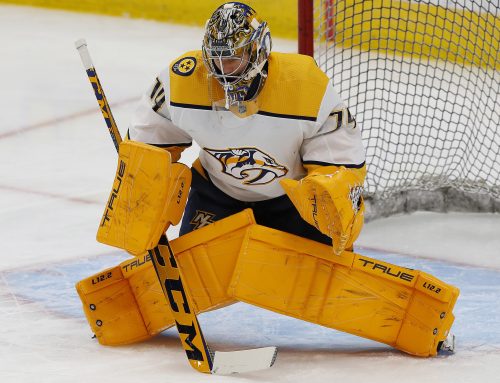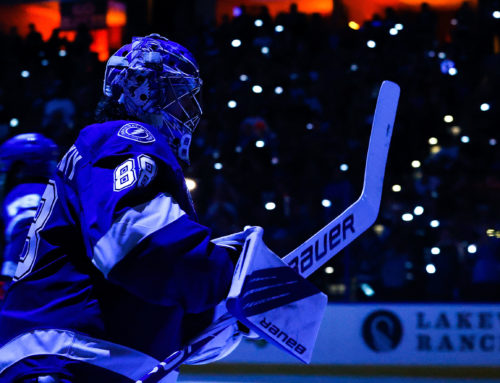Analytics Advantage: Navigating Complexities Early in the Fantasy Season
Stas Pupkov
2023-10-12
Welcome to the Regular Season of the NHL! As the puck drops and teams hit the ice, fantasy hockey managers are equally busy setting their lineups, making trades, and scouring the waiver wire. The excitement is intense, and the early weeks of the season are a crucial period that can significantly influence your chances of making the fantasy playoffs. Whether you’re a seasoned manager or a newcomer, the choices you make now can have long-lasting effects on your team’s performance. In this week’s article, we’ll explore how to successfully navigate the complexities of the early season, equipping you with the insights you need to make informed decisions in your fantasy hockey league.
Optimizing Lineup Decisions in the Early Weeks
The early weeks of the NHL season are a hotbed of activity for fantasy managers. Lineup decisions are more than just a weekly task; they’re a strategic endeavor that can set the trajectory for your entire season. But how do you make the right calls when the season is just getting started, and the data is still sparse?
Utilizing Small Sample Sizes: While it’s tempting to rely on last season’s stats, the new season brings new dynamics. Players switch teams, lines get shuffled, and rookies make their debut. Even a small sample size of games can offer valuable insights. Look for patterns in ice time, shooting percentages, and even advanced metrics like Corsi to gauge a player’s current form.
Balancing Risk and Reward: The early season is a time for calculated gambles. Maybe you’ve spotted an undrafted rookie who’s getting significant ice time, or perhaps a veteran is showing signs of a breakout year. Weigh the potential upside against the risk to make informed decisions.
The Waiver Wire: The waiver wire is particularly fruitful in the early weeks. Managers often make knee-jerk reactions, dropping players who could be valuable assets later in the season. Keep an eye out for these opportunities and don’t hesitate to make a move.
Injuries: Injuries are an unfortunate reality in hockey, but they also create opportunities in fantasy leagues. Backup players get a chance to shine, and savvy managers can capitalize on this by picking up these temporary gems.
Leveraging Analytics for Trade Decisions
Trading is an integral part of fantasy hockey, and the early weeks of the season present a unique window for savvy managers to capitalize on market inefficiencies. But how can you ensure that you’re making trades that will benefit your team in the long run?
Understanding Player Valuation: The key to any successful trade is understanding the true value of the players involved. This goes beyond just looking at points scored. Consider other metrics like shooting percentage, time on ice, and even advanced stats like PDO to get a more comprehensive view of a player’s worth. Check out our Frozen Tools for more on these advanced stats.
Timing is Everything: The early season is rife with overreactions. A player off to a hot start may be overvalued, while a slow starter might be undervalued. Use this to your advantage by timing your trades to capitalize on these market inefficiencies.
The Importance of Depth: While it’s tempting to go after the big names, don’t underestimate the value of depth players. They may not be the flashiest names on the roster, but their consistent performance can be invaluable, especially during the grueling NHL season.
Analyze, But Don’t Overanalyze: Data is a powerful tool, but it’s also easy to get lost in the numbers. Use analytics to inform your decisions, but also trust your gut. Sometimes the eye test can reveal things that the stats don’t.
The Role of Special Teams in Fantasy Hockey
Special teams play a significant role in the NHL, and understanding their impact can give you an edge in your fantasy league. Power play and penalty kill units often feature a team’s top talent, providing additional scoring opportunities.
Power Play Specialists: Some players excel on the power play, racking up points that can be invaluable in fantasy hockey. Identifying these specialists can add a unique dimension to your team.
Penalty Kill Impact: Players who excel in penalty-killing not only contribute defensively but can also chip in with short-handed goals and assists. These stats are often overlooked but can be a tiebreaker in close matchups.
Managing Your Goaltenders
Goaltending can make or break your fantasy season. The position is notoriously volatile, but it’s also one of the most critical in fantasy hockey.
Streaming Strategy: If you didn’t manage to draft an elite goaltender, consider a streaming strategy. This involves picking up goalies with favorable matchups or hot hands off the waiver wire.
Backup Goalies: Don’t underestimate the value of a strong backup goalie, especially during back-to-back games or when the starter is going through a rough patch.
The Long-Term View: Stashing Prospects and IR Management
It’s easy to get caught up in the week-to-week grind of the fantasy season, but successful managers also have an eye on the future.
Stashing Prospects: If your league has a minor-league or prospect roster, consider stashing away young talent that could make an impact later in the season.
Injured Reserve Strategy: Utilize your IR spots wisely. Stashing an injured player who is expected to return and make a significant impact can be a savvy move.
Advanced Trade Strategies
While we’ve touched on the basics of trading, there are more advanced strategies that can set you apart from your league mates.
Buy Low, Sell High: This classic stock market principle applies to fantasy hockey as well. Identify players who are underperforming but have a track record of success and try to acquire them at a discount.
Multi-Player Trades: These are more complex but can be incredibly rewarding. The key is to identify needs on both sides and find a win-win scenario.
Fine-Tuning Your Bench and Flex Spots
As the season gets underway, fantasy managers often focus on their starting lineup, overlooking the potential impact of their bench and flex spots. These positions, although not as glamorous as your starting roster, can be the difference between a win and a loss in any given week. Here’s how to make the most out of these often-neglected spots on your fantasy hockey team.
The Versatile Bench: A well-rounded bench is essential for navigating the ups and downs of the NHL season. Injuries, slumps, and unexpected healthy scratches can wreak havoc on your starting lineup. Having a versatile bench allows you to make last-minute adjustments without sacrificing performance. Look for multi-position eligible players or those who contribute across multiple categories to maximize your bench’s effectiveness.
Utilizing Flex Spots: Flex spots offer a unique opportunity to capitalize on matchups and player hot streaks. Unlike fixed positions, flex spots allow you the freedom to insert a forward, defenseman, or sometimes even a goalie, depending on your league’s settings. Keep an eye on favorable matchups and recent performance to make the most out of these flexible positions.
The Importance of Category Coverage: In category-based leagues, it’s crucial to have bench players who can contribute to areas where your team may be lacking. Whether you need help in faceoff wins, hits, or blocked shots, targeted bench players can provide a much-needed boost in specific categories.
Streaming Strategy for Bench and Flex: If your league allows daily lineup changes, consider a streaming strategy specifically for your bench and flex spots. This involves picking up players with favorable short-term matchups and dropping them once the matchups are less favorable. It’s a high-maintenance strategy but can pay off significantly if done correctly.By giving due attention to your bench and flex spots, you not only prepare for the unexpected but also add another layer of strategy to your fantasy hockey management. Fine-tuning these positions can provide you with the edge you need to outperform your competitors, not just in the early season but throughout the entire NHL schedule.
The Early Bird Gets the Worm
The early weeks of the NHL season are more than just a starting point; they’re a critical juncture that sets the stage for the rest of your fantasy hockey campaign. From optimizing your lineup decisions to leveraging analytics for trades, the strategies you employ now can have a lasting impact on your season. Don’t underestimate the power of a well-rounded bench and the flexibility of your flex spots; these are the finer details that can make or break your fantasy season. As we navigate the excitement and unpredictability of these initial weeks, remember that every decision counts. Whether you’re a seasoned fantasy hockey manager or new to the game, the time to act is now.




 NYI
NYI CAR
CAR T.B
T.B FLA
FLA TOR
TOR BOS
BOS VGK
VGK DAL
DAL EDM
EDM WSH
WSH L.A
L.A COL
COL VAN
VAN WPG
WPG NYR
NYR NSH
NSH ANA
ANA CGY
CGY
